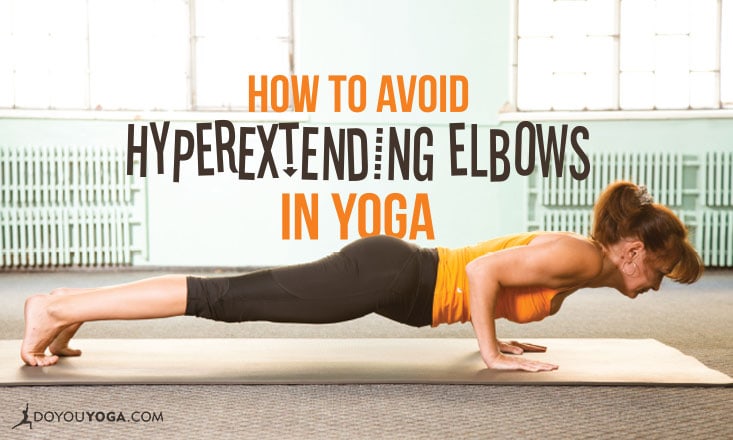The body is meant to move, act, and function in more or less the same way for each person. Slight tweaks to the body’s anatomical plan, however, create situations that we need to modify individually for our yoga practice.
An elbow joint that hyperextends is one of these anatomical situations that may need more careful attention.
What is Hyperextension of the Elbow?
The elbow joint is a hinge joint made up of three bones; the humerus of the upper arm, and the radius and ulna of the lower arm. These three bones are held together at the elbow joint by ligaments and tendons.
When you straighten your arm and extend the elbow joint, anatomically the arm should make a 180 degree angle. If the joint opens more than 180°, it is said to have hyperextended.
What is Wrong with Hyperextending Elbows?
Well, nothing necessarily. In everyday life this may not impact you at all. In fact, some of us will naturally be hyperextenders of certain joints. Some of us will naturally be hypoextenders, although this is not a common term.
The problem with having a natural hyperextension of the elbow joint, or one that is created during exercise is that over time, it can wear down the capsule, cartilage and weaken the joint.
What are the Symptoms?
Repeated use of a hyperextended elbow joint during yoga poses will cause soft tissue damage. You may experience pain, or the muscles of the arm may spasm. You may also have loss of arm strength or numbness may occur.
Rest (lots of rest and disuse of the arm) and icing are usually suggested to someone experiencing symptoms of a hyperextension. If the damage is severe enough, surgery may be recommended.
Tips to Avoid Hyperextending the Elbow Joint
Avoid “locking out” when in a weight bearing pose where the arms are fully extended.
Locking out the joints puts the body’s weight into the joint and the bones, while the muscles have nothing to do with support. Find support for your pose by engaging the surrounding muscles and supporting joints as much as possible.
Examples of yoga poses to avoid “locking out”: Handstand, Downward Facing Dog, and Side Plank.
Balance opposing forces.
The arm will usually have a greater external spiral when dealing with elbow hyperextension. Balance the external spiral with an internal spiral. When in poses that support body weight, in particular, grip with and add weight to the thumb and forefinger side of the hand. Gripping with the index finger will slightly counteract and reduce the elbow hyperextension.
Examples of yoga poses in which to engage an internal spiral: Downward Facing Dog, and warm-up poses on hands and knees like Cat and Cow.
Add a micro-bend to the elbow joint in positions where arms are raised overhead.
This tip is especially for individuals whose hyperextension is causing some level of discomfort.
Examples of yoga poses in which to incorporate a micro-bend: Warrior I, Crescent Lunge, and Tall Mountain.
Pull the top of the humerus, the upper arm bone, into the shoulder socket.
This is going to engage a good portion of your back muscles during weight bearing poses, and helps you to avoid locking or overstretching your shoulder girdle, which in turn, helps the arms to find support they need so the elbow joints are not compensating for lack of engagement elsewhere.
Examples of yoga poses in which to engage the humerus into the ball and socket joint of the shoulder girdle: High Plank, the beginning of Chaturanga if you go from high to low pushup, Downward Facing Dog.
Are you naturally a hyperextender in the elbow joint? What have you found that helps you the most to maintain a safe yoga practice?


